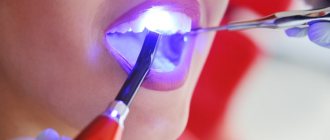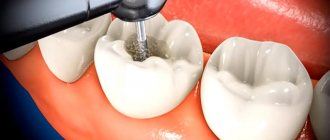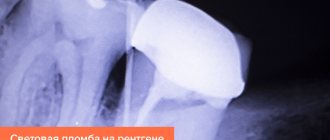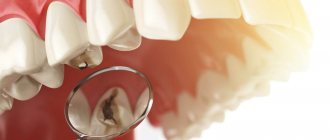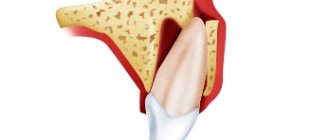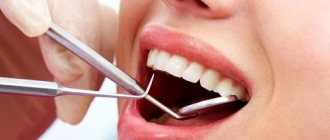Memo to the patient after caries treatment and dental filling.
Today, modern filling materials can last for decades – they are so durable and aesthetically pleasing. However, the service life largely depends not only on professional treatment, but also on the attitude of the patient himself - it is important to have professional teeth cleaning at least once a year, as well as follow some simple recommendations to ensure that the filling lasts as long as possible.
If the filling creates discomfort after treatment
Even in the dental office, after placing the filling, be sure to make sure that the restored tooth does not interfere, i.e. does not overestimate the bite (to do this, you need to create chewing movements of the lower jaw forward and backward, sideways, carefully close your teeth). The filling should not be felt or change the bite. There is no need to be embarrassed to talk about this discomfort to your doctor - sometimes the final stage of filling treatment can take even more time than preparing carious cavities and applying filling material, because The doctor’s main goal is to create multiple contact points between the filled tooth and the antagonist and in no case “turn off” the filling from the bite because this is fraught with changes in the temporomandibular joint.
After treatment, local anesthesia wears off within 1.5-2 hours. If a conductor type was used, then after 4-6 hours. Then you begin to fully feel the restored tooth, you can fully close your jaws and understand how comfortable you are after the treatment.
If you experience a little discomfort, you feel like the tooth is a little higher and your jaw isn't closing quite tightly - this is normal. The fact is that now you have been given a new filling in accordance with the bite, that is, with the shape and position of the antagonist tooth located on the opposite side. Therefore, if there is no sharp pain, be patient for a few days. If the situation normalizes and you get used to it, then there is no reason to see a doctor. If discomfort persists for 1-2 weeks, you should visit your dentist to have the filling corrected.
Causes of tooth pain after filling
Pulpitis
The appearance of acute, spontaneous pain that grows and intensifies at night in a filled tooth may be due to the development of chronic or acute pulpitis. If such symptoms are detected, it is necessary to contact a dentist as soon as possible to remove a previously placed filling, remove the inflamed pulp, fill the root canals and the carious cavity itself.
Development of secondary caries
The source of pain in the tooth after filling can also be secondary caries, which gradually develops under the filling. The most common causes of this pathology are:
Causes of secondary caries
- insufficient disinfection of the carious surface before placing a filling;
- displacement of the installed filling under the influence of external factors;
- shrinkage of the filling material, which contributes to the formation of gaps between the filling and dental tissues;
- injury resulting in damage to the filling;
- irregular oral hygiene;
- violation of filling technology.
Treatment of secondary caries
When a secondary caries process is detected, the dentist removes the previously placed filling, cleans the resulting cavity from destroyed tissue, disinfects it and re-fills the tooth.
Underdrying or overdrying of the cavity
The causes of spontaneous pain that increases with biting in a treated tooth may be under-drying or over-drying of the tissues before filling. Before applying adhesive preparations, the surface dental tissues must be dried to a “wet sand” state (that is, the surface must remain wet, but there cannot be drops of water on it).
Consequences of overdrying tissues
Overdrying of dental tissues leads to damage to the nerve endings located in the surface layers of dentin. In turn, the death of nerve fibers can cause inflammatory damage to the pulp and other serious complications. Mild pain caused by overdrying of the carious cavity most often goes away on its own within 5-13 days. In situations where pain intensifies or persists for two weeks, patients are advised to return to the dental clinic for help.
Consequences of not drying the cavity
Failure to dry out the treated carious cavity can also cause pain. Drops of moisture prevent the penetration of adhesive preparations into the dentinal tubules, therefore, when the filling material shrinks, the composite easily comes off from the cavity floor, thereby forming pathological sinuses in the dental tissues. The only way out of this situation can be to replace the previously installed filling.
Granuloma or dental cyst
One of the likely causes of tooth pain after filling may be the formation of a granuloma (a localized area of inflamed tissue) or a root cyst (a pathological cavity in the gum tissue filled with bacteria, dead cells, blood and other physiological fluids). Granulomas and cysts are treated both conservatively (for example, using the depophoresis method) and through surgical intervention (cystectomy, hemisection, etc.).
Allergic reaction
In some cases, pain in a filled tooth can be the result of an allergic reaction to the components of the filling material. The clinical picture may be supplemented by urticaria, the appearance of an itchy rash and swelling on the patient’s skin and mucous membranes. If a patient is diagnosed with an allergy to the material used, the filling is immediately replaced.
How much should you not eat after getting a filling?
If a filling made of chemical composites is installed, then you should refrain from eating and drinking for 2 hours. This is due to the fact that the material requires a certain time for final hardening.
If a “light” composite filling is placed, you can drink immediately, but you should abstain from food for 1.5-2 hours. But the reason is not in the material (it hardens a few seconds after applying and polymerizing a special lamp), but in anesthesia - with reduced sensitivity of the mucous membranes during eating, you can injure the mucous membranes of the cheeks and lips.
During the day after the filling is installed, you should only consume foods that are temperature-neutral - excessively hot or cold foods can lead to deformation of the filling. It is necessary to chew food on the opposite side for the first day - this will allow the material to fully “adhere” to the tooth tissues, without the risk of damage.
What to do if the filling is in the way?
At an appointment with a specialist, the patient cannot always evaluate his feelings due to the effect of painkillers. Only after a few hours can the filling begin to be felt. Discomfort and a feeling of tooth enlargement may persist for several days. Then the bite will be restored, the discomfort will disappear. If pain occurs and the sealed area bothers you for a week or more, you should immediately consult a specialist.
Often, discomfort after filling is associated with periodontitis. In this case, a periodontist is involved in the therapeutic treatment. Depending on the diagnosis, it is possible to remove the filling, further treatment and install a temporary filling on a special insulating pad.
To maintain a normal bite after treatment, experts advise contacting the clinic if any discomfort occurs. The doctor at our dentistry in the South-Eastern Administrative District will grind the filling, which will take no more than 10 minutes.
All articles
5% discount Print coupon from our website
Ask your question on the website Get professional advice!
If your tooth hurts after getting a filling
Minor pain may persist for several days or even a couple of weeks, which is explained by overheating of the tissue due to the use of boron, and therefore the preparation is usually carried out with cooling with water. In some situations, for example, with deep caries or when treating front teeth, increased sensitivity can persist even for several months. But in such a situation, you should still consult a doctor for an x-ray to make sure that there is no infected tissue left under the filling and that inflammation has not affected the nerve.
Root canal treatment as a cause of toothache
Root canal treatment is always necessary when the dental nerve is affected or completely dead (pulpitis). In this case, the dentist “opens” the tooth with a drill and exposes the root canal system. Then the dental nerve and possible bacterial deposits inside are removed mechanically, the root canals are washed with an antibiotic, and then the cavities are closed with a suitable filler.
These root fillings may cause pain when squeezed, especially in the first few days after treatment, as the filling and treatment can irritate and sensitize the surrounding nerve tissue in the gums. Minor swelling may also occur. However, symptoms usually go away on their own after a few days. If they persist for more than a week or become significantly worse, you should contact your dentist immediately.
Can my gums hurt after filling?
The gums in the area where the anesthesia was administered may ache for several days - this is completely normal and does not require any measures. The mucous membrane may also be slightly inflamed if special rings or matrices were used during treatment, which are placed on the tooth to form the correct shape of its crown and create ideal interdental contact. The gums can also be damaged if the doctor applied the filling material in close proximity to the mucous membrane or even under it - in such a situation, the gums are deliberately moved back, the gums are retracted with a special thread or coagulated. Therefore, pain is a normal reaction to external intervention.
All of these conditions are variations of the norm. But if the pain intensifies, redness and swelling of the mucous membrane progresses, you need to consult a doctor.
Recommendations for eliminating the causes of pain in a filled tooth
If you experience discomfort or pain in a filled tooth, it is recommended:
- eliminate the load on the diseased tooth;
- seek professional dental care immediately;
- stop using traditional medicine.
Procedures related to filling replacement, removal of granulomas and cysts are performed on an outpatient basis and do not require much time.
At the same time, timely seeking dental care at a 24-hour dentistry allows you not only to get rid of unpleasant symptoms in the shortest possible time, but also to prevent the development of serious complications.
How to properly perform hygiene procedures
After treatment, brush the filled tooth carefully, applying minimal pressure to it. Do not use rinses containing abrasive substances and alcohol, which can increase the plasticity of the material - this will lead to a change in the shape of the filling. Also, do not use overly hard brushes - they can leave microcracks in the material, which will not have the best effect on the durability of the filling.
In general, you should take care of teeth with fillings in a completely standard way:
- daily brushing of teeth twice a day - in the morning after breakfast and in the evening after all meals, after - rinsing the mouth with water and rinse,
- To clean the area of filled teeth after eating, it is better to replace dental floss with an irrigator. If you floss (thread) carelessly, you can touch the installed filling, especially if there are thin edges of the tooth, which will lead to its chipping or loss.
What to do if your tooth hurts after installing a filling?
You should pay attention to the nature of the pain. If it is aching, tolerable, and is not associated with food intake, then the chances are high that everything will work out on its own.
You should worry if:
- The pain is throbbing, increases towards night, the sealed tooth with the nerve hurts - this indicates inflammation of the pulp.
- Unpleasant sensations appear only when biting or pressing on the filling - most likely, the filling technology is broken.
- There is a feeling that the tooth is sticking out, there is discomfort when chewing - the filling is too large.
- The mouth burns, the gums hurt, the mucous membrane turns red and swells - signs of an allergic reaction.
- The pain does not decrease, but may intensify. The gums swell, general malaise appears, and the temperature rises. These symptoms indicate that periodontitis is developing.
Is it necessary to follow a diet after caries treatment?
From the diet as a whole after caries treatment (especially if a large filling is installed and your own tooth has very thin walls), it is recommended to remove too hard foods - toffees, chewing gum, grilled fruit, nuts, etc. Or chew them with teeth located on the opposite side (if they do not have fillings).
Minimize the amount of consumed foods and drinks that contain coloring pigments (tea, coffee, beets) - under their influence, the filling material may slightly change its shade. This rule is especially relevant when restoring front teeth.
How to maintain your treatment guarantee
To maintain the guarantee, the patient must strictly follow all recommendations: do not overload the tooth, do not use it for other purposes (for example, opening beer bottles, biting off threads), and also regularly see the doctor in accordance with the individual schedule of medical examinations, approximately once every six months. Unfortunately, many patients forget about this, and it is the last point that is the key to maintaining the guarantee for treatment.
You need to visit a doctor 1-2 times a year. During a preventive examination, the dentist will be able to make sure that the filling is in good condition, and that secondary caries does not develop again under it.
Polishing fillings
Why come in for polishing of a filling after it has been installed?
Filling is a way to restore a tooth destroyed by caries or crumbled. Doctors place a hard material called a filling into the resulting cavity. Dentists at the DaVinci clinic use modern substances to eliminate the resulting voids. This is done to achieve patient comfort and to avoid infection.
If there is no damage to the dental nerve and the need for further diagnosis, doctors place a permanent filling, which, with proper oral care, will last for years. The installation takes quite a long time and takes place in several stages.
What can happen after a filling is installed?
If the filling is not processed correctly, you may experience sensations such as:
- roughness of the tooth surface;
- scratch;
- discomfort when chewing food, pain and stuck pieces of food.
All these signs indicate that during installation the dentist did not fully complete the final stage - grinding and polishing the tooth.
Why polish a filling?
The surface of the tooth cannot be smooth. And the doctor’s task is to give the restored tooth a natural look and shape. Therefore, at the final stage, the specialist sets goals:
- check whether the filling is too high and whether it creates discomfort when eating;
- remove the topmost layer of material, approximately 0.01 mm. It contains too much oxygen, so it has increased abrasion and reduced strength. It also absorbs food pigments and colors the filling;
- bring the tooth to its original form - make it the way it was before destruction;
- erase the boundary between the tooth and the artificial material.
What characterizes proper polishing?
- shine and cleanliness of the tooth surface;
- no pores;
- To clean with a floss, force is required, however, it moves freely along the surface of the tooth from the side.
The final stage is at a separate appointment
Modern composite filling materials are ground and polished immediately after installation in the tooth cavity. However, even the best material requires additional sanding a day or two after installation, as it shrinks slightly (about 1%). That is, immediately after installing the filling, the patient may feel a “bulging” of the tooth, and after a day, part of the material evaporates: the filling becomes more comfortable and pores appear again. Therefore, for a more comfortable use of the filling and to increase its service life, you must “run” to the dentist every other day for literally 15–20 minutes. In addition, if you were not sure after installing the filling about its convenience, after testing the tooth in action a day later, you will confidently point out the problem areas to the dentist.
Add a comment
Leave your comment
Comments
- No comments found
Check yourself: when to see a doctor
If a tooth hurts 2-3 days after the filling is placed, and the pain noticeably intensifies when pressed at night, this may indicate a relapse of caries and damage to the dental nerve. If black spots are visible under the filling several months after treatment, the filling interferes with the closure of the jaws or there is prolonged pain when pressing on the tooth. Do not ignore these symptoms and do not be afraid - this is a reason to contact your attending physician - all work must be carried out within the framework of the guarantee of the medical institution. Timely treatment is the key to the health of your teeth!
Possible causes of toothache after treatment
Tooth and gum pain are important warning signs of disease or injury that requires treatment. Often, symptoms disappear completely when the dentist removes the existing decay and gives the tooth a filling or denture (such as a crown). To prevent tooth preparation from causing pain to the patient, a local anesthetic is usually injected into the surrounding gums, the effect of which wears off completely after a few hours.
Temporary pain immediately after treatment is often harmless.
If pain occurs immediately after the anesthetic has subsided, it is a simple reaction to the procedure and usually goes away within a day. The puncture site of the syringe can also be painful because the anesthetic is applied to the soft tissue with pressure and can cause pain, which, however, also passes quickly. If the pain persists for a longer period of time or even worsens, it is recommended to visit the dentist again to find out the cause and take countermeasures if necessary.



